Figuring out how to feed kids when they're not in school
This article was produced as a project by Kate Bradshaw for the USC Annenberg Center for Health Journalism's 2020 Data Fellowship. It is the first in a series exploring the impacts of the COVID-19 pandemic on local food systems and policies.
Her other stories include:
Part 2: From farms to families
Part 3: Federal program that helps farmers during the pandemic is changing the local food landscape
Part 4: When hazards collide: How local food systems are adjusting to a changing world
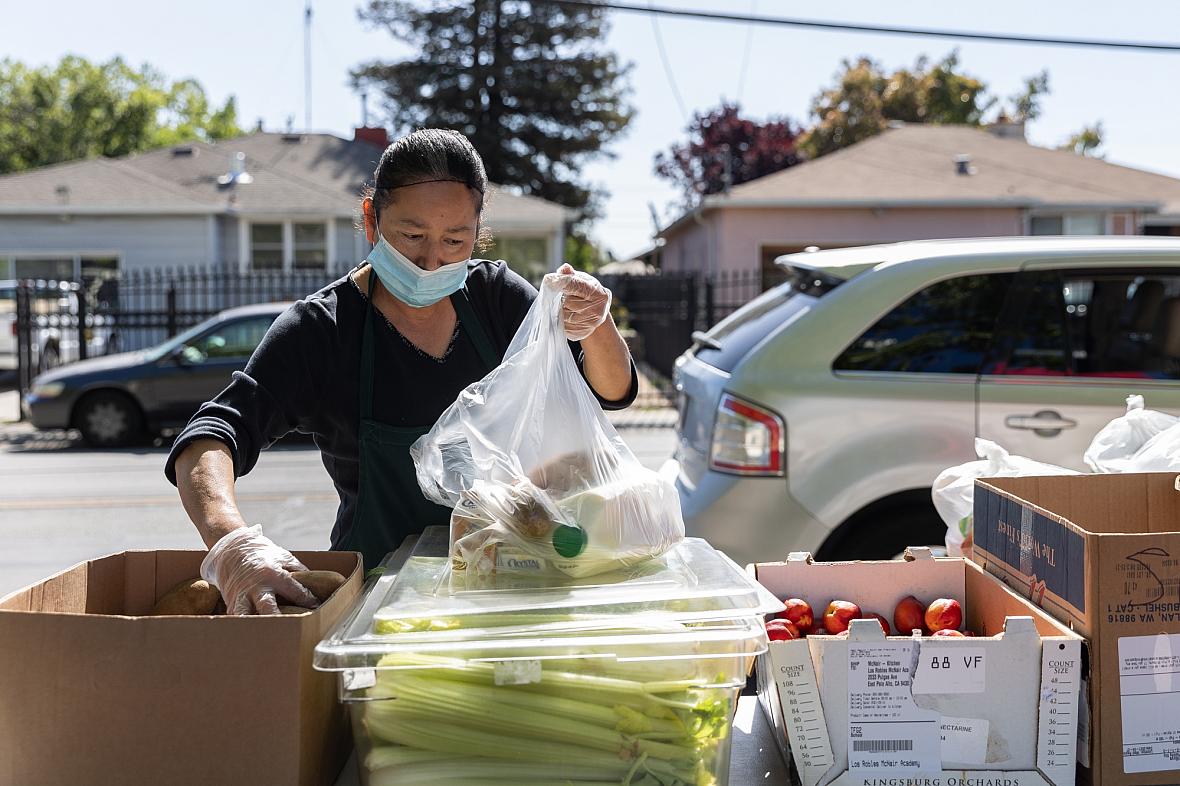
Norma Lazcano places potatoes in a bag at a food pick-up site at the Los Robles Ronald McNair Academy in East Palo Alto on May 19. When the pandemic forced school campuses to close, child nutrition staff had to adapt quickly to make sure families didn't lose access to the school meals that they rely on.
Photo by Magali Gauthier.
Every Wednesday in East Palo Alto, between the hours of 8 a.m. and 2 p.m., parents in vehicles pull over on Pulgas Avenue near the Los Robles-Ronald McNair school campus to pick up a week's worth of food for their families.
On a recent Wednesday, Consuelo Meza and Maria Gonzalez, two student nutrition staffers from the Ravenswood City School District, cheerfully offered food to everyone who showed up, loading bags of milk, juice, meatballs, mini pancakes, raisins, apples, macaroni noodles, cheese sticks and carrots, handing them off into vehicles or leaving visitors to tie the bags onto their bicycle handlebars before riding off.
Each week, their team distributes between 140 and 150 bags of food at that location, Meza said. Conversations with those picking up food indicated that the program was helping them. Marta Andulo of East Palo Alto said in Spanish that she's experienced stress after losing work at a restaurant when it closed, and was picking up the food to help out a grandchild.
Kenneth Pope of Menlo Park said that the pandemic has been hard, but that "it brought the family closer together." The meal program has helped feed his four grandchildren, he added.
Through major efforts to feed children during the pandemic, school districts across San Mateo and Santa Clara counties have offered an important resource to families struggling with unprecedented changes and challenges.
Interviews with school district leaders involved in providing school meals tell a story about widespread and herculean efforts to help families impacted by the pandemic's seismic economic shifts.
An analysis of school meals data by The Almanac shows that while the number of school meals provided to children varied widely between districts, there was an overall 36% decline in the number of school meals distributed in October and November of 2019, before the pandemic, and during the same months a year later, in the heart of the COVID-19 pandemic in San Mateo and Santa Clara counties.
Across the two counties, that meant a total decrease in school meals to about 4.1 million meals compared with 6.5 million in those two months a year earlier.
Without children in classrooms for more than a year, the pandemic forced most school districts to rethink how they feed children and what role schools should play in combating child hunger during the school day, even while kids weren't physically in their care.
During the pandemic, the U.S. Department of Agriculture's Food and Nutrition Service has permitted schools to offer up to two free meals per day to anyone under 18 and issued a series of waivers offering additional flexibility to schools. Most recently, it extended a waiver program to allow its "Seamless Summer Option," which usually runs during summer vacations, to operate during the regular school year through June 30, 2022. With it, schools can continue to provide up to two free meals per day to anyone under 18.
Here's a look at the lessons learned by those on the front lines of child hunger during the pandemic.
What worked
Image
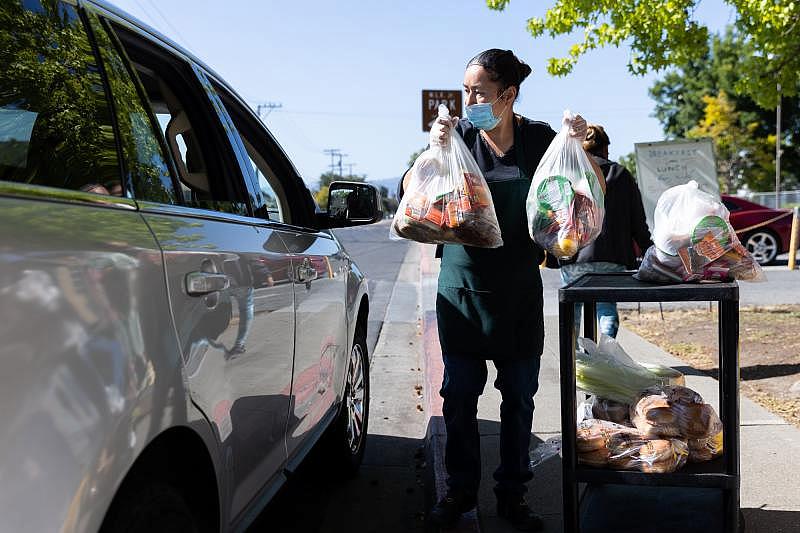
Norma Lazcano lifts bags of food into a client's car at a food pick-up site at the Los Robles Ronald McNair Academy in East Palo Alto on May 19, 2021. Photo by Magali Gauthier.

Norma Lazcano lifts bags of food into a client's car at a food pick-up site at the Los Robles Ronald McNair Academy in East Palo Alto on May 19, 2021. Photo by Magali Gauthier.
Among those leading the charge to track school meal distributions during the pandemic is not a celebrated think tank but a rising, youth-led coalition of students and graduates called UnBox, which has built what it believes is the Bay Area's most comprehensive school meals database. Co-founded by 2018 Stanford University graduate Isabelle Foster and current undergraduate Charlie Hoffs, the organization has assiduously tracked and reported where and how to access school meals throughout the region, mapping them on an interactive website, bayareacommunity.org.
Being responsive
In a number of school districts in San Mateo and Santa Clara counties, child nutrition staffers said that they were most successful in listening to the families they work with and responding to their needs. In comparing meals distributed in October and November of 2020 to student enrollment, among the leaders were Luther Burbank School District, a one-school district in San Jose, and the Ravenswood City School District in East Palo Alto and Menlo Park. Generally, school districts with higher numbers of students who experience poverty reported more school meals distributed, though there were some exceptions.
Superintendent Edith Mourtos of the Luther Burbank School District said in an interview that after distributing meals to families every day, the district switched to a weekly "market basket" approach, providing families with healthy ingredients to cook their own meals. As students have come back to school, the district has continued to send them home with breakfasts and suppers, as all of the families in the district are eligible for free and reduced-price lunch, she said. They've also surveyed families to find out what foods they like and have worked with their vendor to order meals that kids enjoy and that stay within the health guidelines for school meals, she said.
"I would say kudos to the kitchen staff for being really responsive to what the kids liked and didn't like," she said.
The Ravenswood district took a similar approach in responding to feedback from families to switch to a weekly meal program, said June Richardson, child nutrition consultant for the district. The most popular meal kit? Pizza, by far, she said.
When the pandemic hit, the district's nutrition program had just finished undergoing a vigorous review process when staffers learned that the district might be locked down. Over a single weekend last March, Ravenswood set up its school meals program. The district experimented with different distribution approaches, offering multiple meals daily, then twice a week. After surveying families, the district now provides seven-day meal kits on Wednesdays, with curbside pickups available between 8 a.m. and 2 p.m.
Staff received some surprising feedback, like from one respondent who didn't want to leave home during that window because it would mean losing a parking spot at a crowded apartment complex. Another said they didn't like receiving so much meat because they didn't have enough room to store it.
Consuelo Meza fills a bag with milk for a client at a food pick-up site at the Los Robles Ronald McNair Academy in East Palo Alto on April 28, 2021. Photo by Magali Gauthier.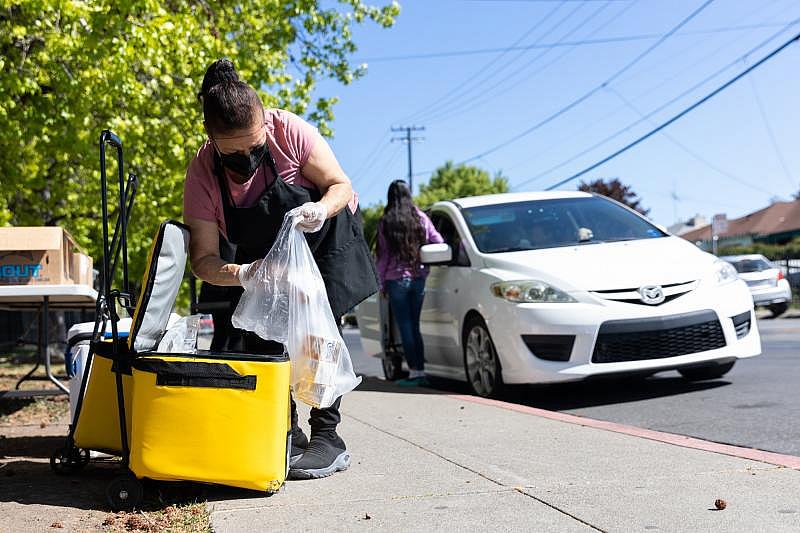
In contrast, the Mountain View Whisman School District took a different approach after getting different feedback from its families, serving grab-and-go breakfasts at each school site daily. The district served record numbers of students during the pandemic and was on track to keep setting records in May, according to Debbie Austin, Mountain View Whisman's director of food and nutrition services. Staff has also been providing meals to about 50 families at Moffett Field military base.
The district's daily meal program reflects that many of its families don't have a lot of refrigerator space, and some don't have access to kitchens or may be doubled up with other families. People were most interested in picking up food around lunchtime, between 11:30 a.m. to 1 p.m., Austin said.
'We've had parents that have literally been in tears saying if it wasn't for us, they wouldn't have food in their families," Austin said. "That's what kept our crew going."
Her crew hasn't skipped a day, providing food to families over the Thanksgiving and Christmas holidays as well as spring break, she said.
"People have to eat every day and food insecurity is only growing. It's not lessening," she said.
People have been laid off longer than they thought, run through their minimal savings, and have been unable to pay rent for eight, nine or 10 months, and are concerned they'll be evicted soon, she said.
Since families don't have to apply to participate, they don't experience any stigma that might otherwise come from accessing free school meals, Austin added. "I think parents are thankful they don't have to put breakfast and lunch together," she said.
Networking
Image
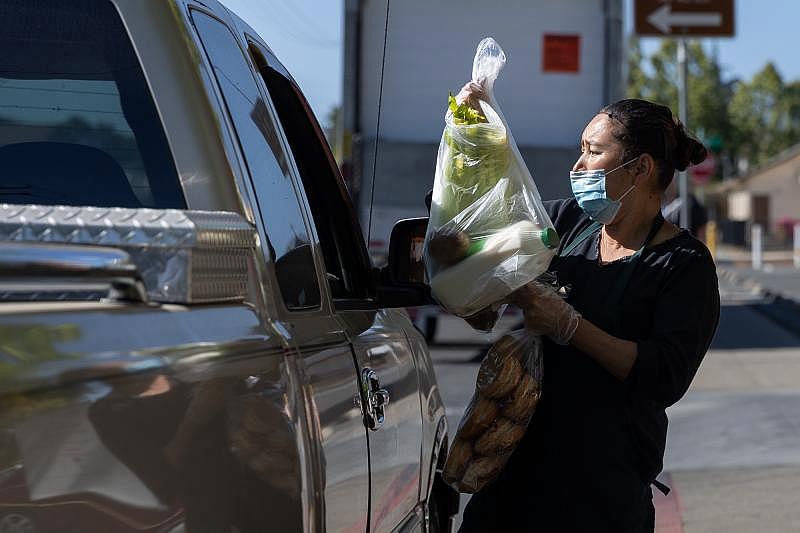
Norma Lazcano places bags of food in a client's car at a food pick-up site at the Los Robles Ronald McNair Academy in East Palo Alto on May 19, 2021. Photo by Magali Gauthier.

Norma Lazcano places bags of food in a client's car at a food pick-up site at the Los Robles Ronald McNair Academy in East Palo Alto on May 19, 2021. Photo by Magali Gauthier.
Another key approach that aided Richardson of the Ravenswood district was to broaden her network through the Midpeninsula Pediatric Advisory Coalition, a multidisciplinary team led by Stanford Children's Health that formed during the pandemic to help mitigate the pandemic's indirect impacts on local children.
During the group's twice-monthly meetings, members including Richardson learned about the needs facing the community and took action, said Dr. Lisa Chamberlain, who co-founded the group with Dr. Janine Bruce.
"The implications of food insecurity are so far-reaching," Bruce said. "I think that when everybody was so uncertain during the pandemic, schools became one of the primary anchor points for meals for kids."
They worked with food organizations like East Palo Alto's Ecumenical Hunger Program to supplement the meals that organization was providing by purchasing more protein-rich foods.
"We bought them so much peanut butter and tuna," Chamberlain recalled.
The coalition also crafted bilingual flyers with information about pandemic resources for families that were sent out with school meals. San Mateo County librarians, part of the coalition, pitched in by using their empty library facilities to make thousands of copies.
"It was just this really wonderful partnership where everybody comes together to make things happen," Chamberlain said.
Richardson also created public-private partnerships to bolster her efforts. Through a partnership with Palo Alto-based VMware, the district received fruit donations through most of the year. Her team partnered with Facebook and other organizations that bought food from local restaurant vendors to provide special meals and meal kits, she said. And she was able to get gift cards and meal donations for her staff. Those, along with certificates signed by the district superintendent that she created to thank her staffers, boosted morale, she said.
"You would think they all got a piece of gold," she said, describing staff members' response to the certificates.
Another tool was using social media, specifically the EPA Neighbors page on Facebook, to spread the word about the meal offerings, she said.
Make it convenient
Irma Muñoz places bags of food in a client's car at a food pick-up site at the Los Robles Ronald McNair Academy in East Palo Alto on May 19, 2021. Photo by Magali Gauthier.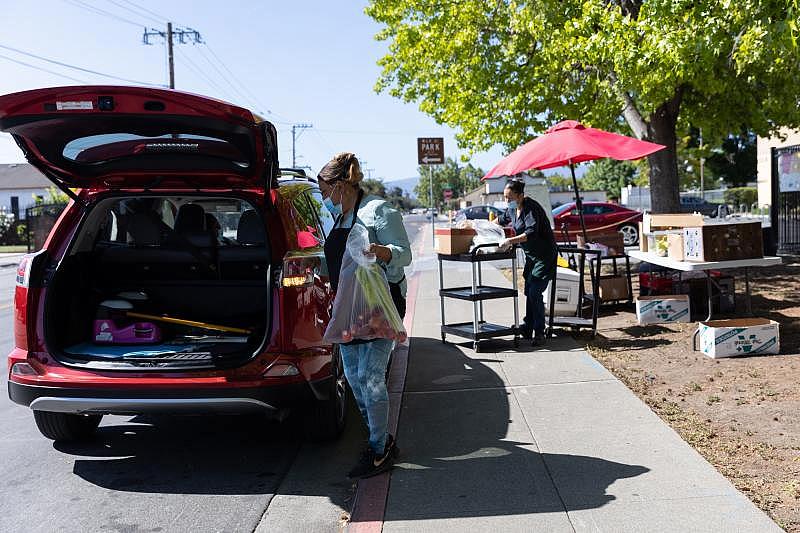
"At one point our home delivery was 60% to 70% compared to curbside," Richardson said. Families would call by 9 a.m. and leave a message saying how many children they had and where they lived. In the beginning, this option was more popular because "nobody wanted to come out," she said. As time went on, people began to pick up items in person more.
Through the "Seamless Summer" policy offered through the USDA's Food and Nutrition Service, the district has also been providing meals for neighboring charter schools, Montessori schools and local day cares.
"It's not restrictive to just students enrolled in your school," she said. "It opens up to anybody in the community."
She and her team just have to count the number of meals they distribute with a simple clicker.
Still, with all the food they're distributing, the participation rate is about 50% less than it would be if students were in school, she said. Richardson said she suspects it's because families are getting food from other places – and given the dramatic uptick in demand that other food organizations are reporting, this may very well be the case.
Second Harvest Food Bank continues to serve twice as much food to twice as many people as it did before the pandemic hit, said Tracy Weatherby, a vice president at Second Harvest, the primary food bank for San Mateo and Santa Clara counties.
And they don't see demand falling any time soon, she said. "Over 50% of our clients we surveyed have less than $100 in savings," she said. "That's not savings. That's not enough cash to pay most people's grocery bills. We're pretty certain this need will continue."
But some families are relying solely on the student meals for their extra food support. Two families picking up meals at a recent distribution in East Palo Alto said in Spanish that they weren't getting nutritional aid from anywhere else.
Use existing staff in new ways
Other school districts, like the Jefferson Elementary School District in Daly City, met the new needs of their students by shifting the roles of existing staff members to help battle child hunger. Stephanie Martinez, program director of student services with the district, who also leads the district's counseling program, said that many of her 15 counseling staffers switched to helping families get access to food – though counseling services continued during the pandemic as well.
They served food to between 100 to 250 families each month, said Arthur Melendez, a counselor with the district. They also retooled their menu, from hot meals to a grab-and-go style, after learning that the meals would sometimes be soggy or cold by the time they were picked up, and supplemented them with fresh produce through Second Harvest.
For families that couldn't come pick up meals, counselors and district staff members delivered the meals to families themselves. Among the reasons that families didn't pick up meals were that they were sick with COVID-19, didn't have a car, lost their insurance, couldn't pay for gas or had too many kids to fit into the car, Martinez said.
She and her team also brought in additional resources through grants and were able to provide some bus passes and direct financial support to families.
Counselors, Martinez said, are "like super power people. They do take on a lot. We had to step outside our traditional roles and do things we would never be expected to do."
Ravenswood City School District staff prepare bags of food on May 19. After surveying families, the district now provides seven-day meal kits on Wednesdays. Photo by Magali Gauthier.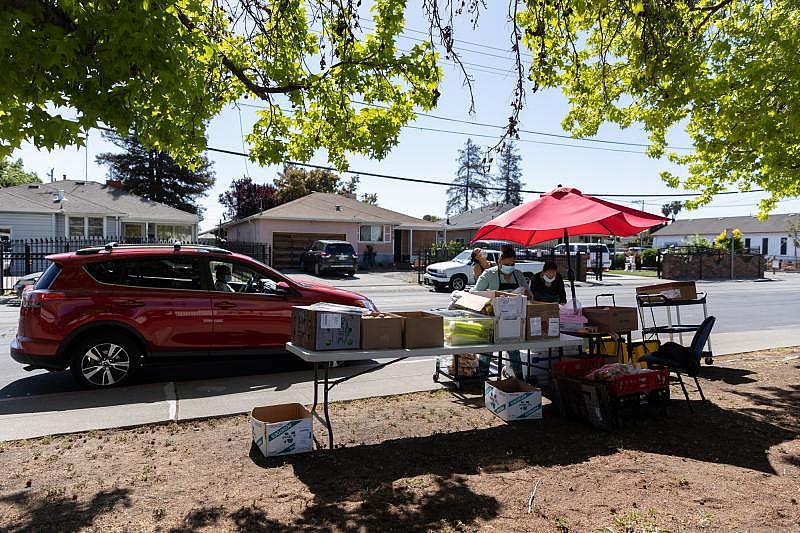
What didn't work
The global pandemic triggered plenty of challenges: Children were away from school, some families moved without reporting their new addresses and some were fearful of leaving home. Even so, it was a requirement in some districts for parents to bring the child with them when picking up food.
According to Weatherby, the free and reduced price meal program poses some obstacles to getting meals to children who could benefit. One is that some families are afraid to apply, perhaps concerned that it will negatively affect their immigration status. Another is that the income eligibility requirements are so low that they don't include people who still struggle to pay for food. "There are plenty of people struggling making over 185% of the federal poverty limit," she said.
Yet another challenge associated with school meals outside of the "Seamless Summer Option" is that to be eligible for free and reduced-price meals, federal guidelines don't take into account the significantly higher cost of living associated with the Bay Area, Martinez said. She noted that a lot of families and community members work in labor fields that may not provide full benefits, more than part-time pay or minimum wages to their workers.
To be eligible for free meals at school, a family of four can earn no more than $34,450 and no more than $49,025 to receive reduced-cost meals. The fair market rent of $2,923 for a one-bedroom apartment in San Mateo County (according to rentdata.org) is more than the monthly income threshold for free lunches of $2,871.
On one hand, there may be less stigma to getting school breakfasts and lunches than in going to a food bank, suggested Mary McGrath, executive director of Safe and Supportive Schools, a San Mateo County initiative focused on school-based behavioral and mental health services. On the other hand, she said, funds can be limited because some districts tend to undercount the number of children who are eligible for McKinney-Vento funds, a program aimed at making school services more accessible for students who experience homelessness or significant housing insecurity. One district, McGrath said, reports only having four students eligible for such funds, but contains a whole street full of RVs where children are living.
Yet another obstacle is that gaining access to free and reduced-price meals requires a certain amount of digital literacy from the families, but with little training and support available, Martinez said.
Many applications for housing, finances or food support are now online, and those take certain resources and skills to navigate. Families don't always have the documents or the tools to scan and upload the requested information, Martinez said.
"All of these things we learned as college students and educators – our families have never had to do this," she said. An assortment of food, including milk, pancakes, apples, carrots, pasta, raisins and cheese are ready for distribution at Los Robles Ronald McNair Academy in East Palo Alto on April 28. Photo by Magali Gauthier.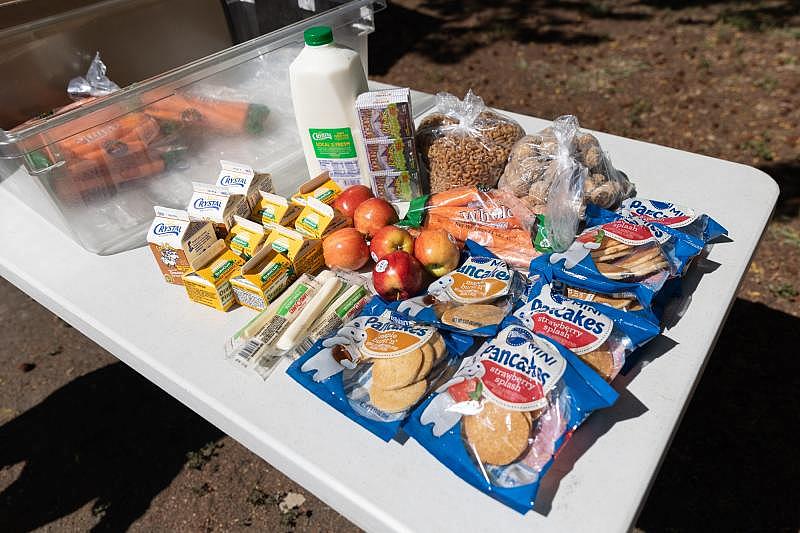
Pandemic EBT cards
One pandemic program aimed at helping keep families fed is the Pandemic EBT program. Families that were eligible for free and reduced-price school meals were sent EBT cards, similar to SNAP/CalFresh cards, loaded with $5.70 per student per day, roughly covering the number of days that school was not in session. The $5.70 aimed to cover the cost of breakfast and lunch. However, families that were not already qualified for the program had to fill out applications. Martinez said it was hard for her counseling staff to navigate the applications, and they had to spend time going through rather personal questions with applicants.
In the first round of the Pandemic EBT program, in which cards were mailed to eligible households, San Mateo County reported one of the largest gaps between estimated eligible participants and actual participants among California counties – the EBT cards reached only 85.9% of the estimated children who were eligible. The proportion in Santa Clara County was 90.4%, according to a California Department of Social Services report.
One reason for the gap in San Mateo County was that a number of families moved out during the pandemic, and the cards missed them in the mail, McGrath said.
"The address change issue is difficult ... even for well-intentioned organizations trying to implement that," Weatherby said.
The next round of pandemic EBT is set to be disbursed shortly, with cards expected to be mailed to eligible families between June 21 and July 31, according to a state memo.
What's next
Given all of the new ways of combating child hunger that were initiated during the pandemic, it's perhaps unsurprising that there are efforts in the works to codify some of those changes. Assemblyman Marc Berman (D-Menlo Park), whose District 24 represents parts of San Mateo and Santa Clara counties, last year proposed a bill to reform the community eligibility provision, and this year is a principal co-author of state Sen. Nancy Skinner's "Free School Meals for All Act," Senate Bill 364. The legislation would promise free breakfast and lunch for all California students and end the application process to receive free meals.
If the proposed legislation passes, it will increase the workload for school meal providers, requiring more staffing and equipment.
At the same time, "It's going to help farmers. It's going to help everybody that produces food. It's going to spread the wealth," said Austin of the Mountain View Whisman School District.
"If you think about every other industrialized country in the world, they do not charge children in school for food," she said. "We're just now getting on the bandwagon."
This article was produced as a project for the USC Annenberg Center for Health Journalism's 2020 Data Fellowship. It is the first in a series exploring the impacts of the COVID-19 pandemic on local food systems and policies. Second Harvest of Silicon Valley and UnBox provided data.
Email Staff Writer Kate Bradshaw at kbradshaw@almanacnews.com.
[This article was originally published by The Almanac.]
Did you like this story? Your support means a lot! Your tax-deductible donation will advance our mission of supporting journalism as a catalyst for change.

